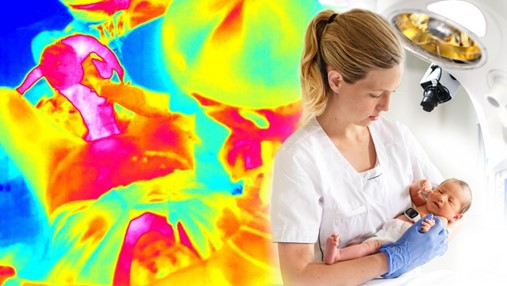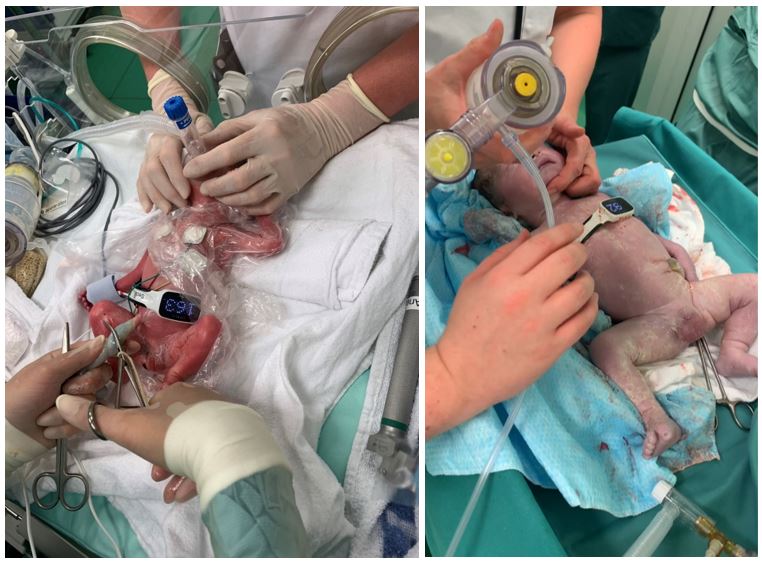The team collects objective birth data to determine the effects of different interventions on the quality of care and outcomes.
Goal
To gain knowledge that can help reduce the unacceptably high burden of neonatal morbidity and mortality caused by birth asphyxia and prematurity globally.
Key achievements
- Gained new knowledge on resuscitation of near-term and term newborns by collecting objective resuscitation data; heart rate signals immediately after birth and throughout resuscitation, ventilation data and video recordings.
- Defined optimal low-dose high-frequency newborn resuscitation training.
- Demonstrated impact of immediate Kangaroo Mother Care (iKMC) to reduce mortality in low- and middle resource settings and reduce morbidity in high-resource settings.
What we learned
We’ve run several parallel research projects together with Safer Births.
NeoBeat, a dry-electrode ECG device, was used on approximately 8000 newborns for two years. This provided valuable information on newborn heart rate immediately after birth and during resuscitation. In newborns requiring resuscitation, NeoBeat was shown to be faster to place, show heart rate more rapidly, and provide accurate feedback on heart rate for a larger proportion of time during ongoing resuscitation compared to the standard 3-lead ECG and pulse oximetry devices.
Refresher training is key
In a randomized control trial of low-dose high-frequency in-situ simulation training, simulation improved competence significantly for all participants, and inexperienced workers performed as well as experienced workers in the end. No training as compared to monthly training (at minimum) was identified as a clear benefit to regular training. The novel NeoNatalie simulator was used in low-dose high-frequency training studies and showed consistency when compared to ventilations from real-life newborns being resuscitated after birth.
A need for increased visibility
Studies of tidal volumes delivered during newborn resuscitation with t-piece resuscitator found a substantial variation in tidal volumes despite a relatively stable inflating pressure. Delivered tidal volumes were at the lower recommended range. The study highlights the need for monitors that can display delivered volumes.
25% reduction in premature mortality
In the Immediate Kangaroo Mother Care (iKMC) trial conducted in low-and middle resource settings, immediate and continuous KMC for premature infants resulted in a 25% reduction in neonatal mortality. Results from the Scandinavian immediate KMC study on physiological stability after birth are submitted.

Using AI to learn from real births
In collaboration with partners, we are developing Newborn Timelines using artificial intelligence (AI) for activity and event recognition in thermal and optic video from the time of birth and during newborn resuscitation. Newborn Timelines will allow for systematic data-driven debriefing and targeted simulation training after resuscitations.
“As healthcare providers involved in newborn resuscitation, we should always be aware that our performance may have ultimate consequences for the newborn. There is no substitute for preparation and dedicated training.”
– Prof. Siren Rettedal, Stavanger University Hospital, Stavanger, Norway

The Team
Prof. Siren Rettedal, Prof. Hege Ersdal, Dr. Joanna Haynes, Dr. Peder Bjorland, Dr. Hanne Pike, Dr. Jørgen Linde, Dr. Amalie Kibsgaard, Dr. Karoline Lode, Stud. Med. Mia Elida Ersdal, Research Assistant Sissel Boren, Research Assistant Elise Lerand, Data analyst Cecilie Grøtteland, Statistician Jan Terje Kvaløy, Statistician Anastasia Anastasia Ushakova
Partners
- University of Stavanger
- Laerdal Global Health
- BitYoga
- Health West ICT
- Department of Analytics, Stavanger University Hospital
- Karolinska Institute, Sweden
- Haydom Lutheran Hospital, Tanzania